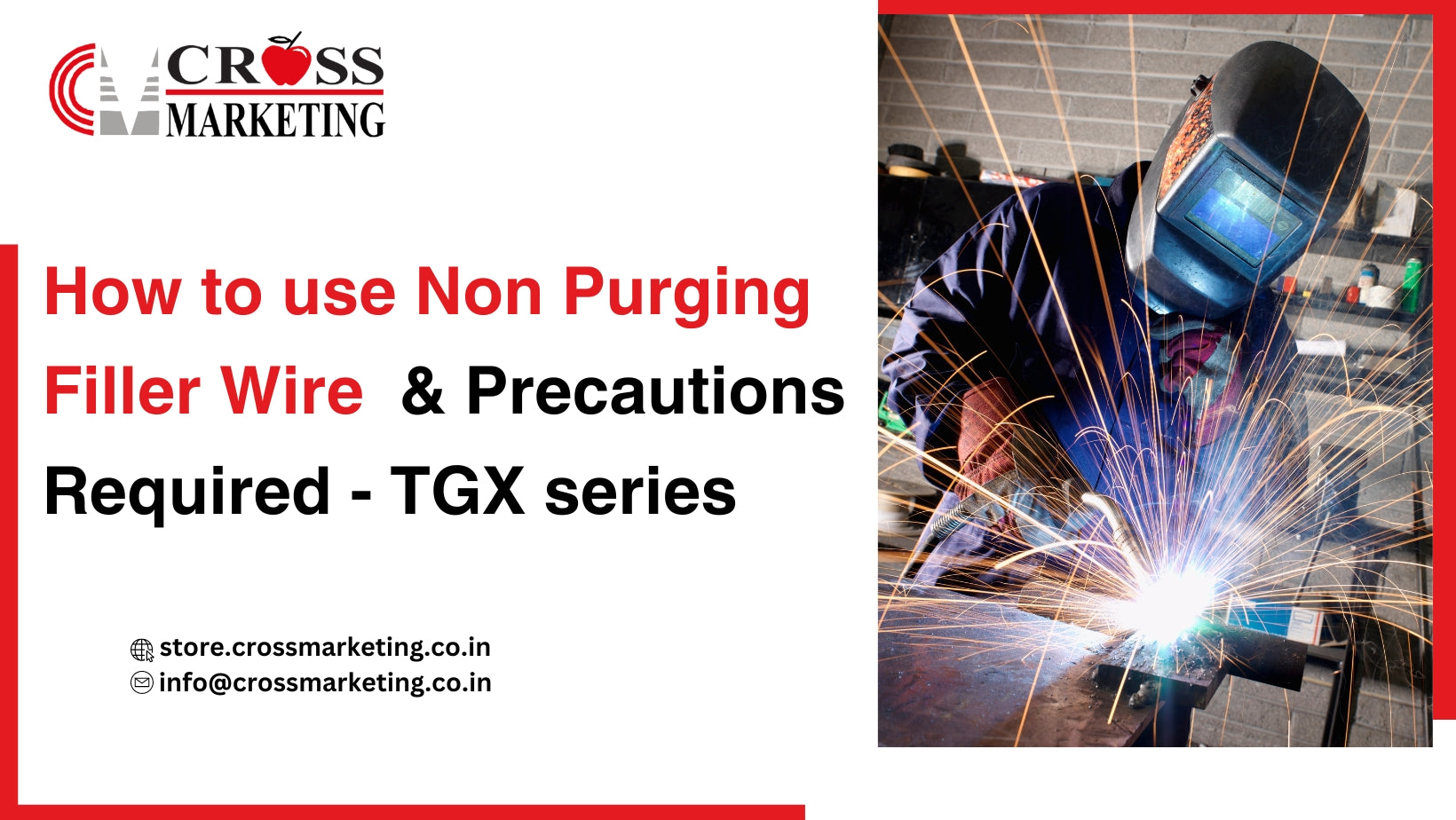How to use Non Purging Filler Wire & Precautions Required - TGX series
1. Non Purging Filler Wire [TGX]
TGX Series Non Purging Filler Wire for TIG welding, produce slag to protect the reverse side of the root pass from oxidation by the atmosphere.
|
Product name |
Applicable base metal |
|
TG-X308L |
Non Purging Filler Wire for SS 304, 304L |
|
TG-X309L |
Non Purging Filler Wire for Dissimilar weld |
|
TG-X316L |
Non Purging Filler Wire for 316, 316L |
|
TG-X347 |
Non Purging Filler Wire for 347, 321 |
|
TG-X2209 |
Non Purging Filler Wire for S32205, S31803 |
Product Button


|
Buttering |
In case steel is MS, please give buttering like red highlighted in image. |
|
|
Buttering shall consist of 2 layer of TGX as per AWS 5.22. Quote from AWS "electrodes or rods of the same classification as that being classified" |
|
Notes : |
A ) Wire Feeding speed shall be slow which seems very slow for welder. Many Welders are apt to weld fast to complete welding quickly. |
|
|
B) High Current(160A) is better to melt the flux surely. |
|
|
Slag which is not melting causes slag inclusion. |
Actual Condition for the EQT
|
Layer
|
Passes
|
Current (A)
|
Voltage(V)
|
Arc Time
|
Interpass Temp (℃)
|
|
|
minute
|
second
|
|||||
|
1
|
1
|
160
|
14
|
3
|
41
|
25
|
|
2
|
2
|
160
|
14
|
3
|
04
|
116
|
|
3
|
3
|
160
|
14
|
2
|
16
|
102
|
|
|
4
|
160
|
14
|
3
|
35
|
128
|
|
4
|
5
|
160
|
14
|
2
|
07
|
130
|
|
|
6
|
160
|
14
|
3
|
19
|
132
|
|
5
|
7
|
160
|
14
|
2
|
35
|
118
|
|
|
8
|
160
|
14
|
3
|
32
|
126
|
|
6
|
9
|
160
|
14
|
2
|
39
|
131
|
|
|
10
|
160
|
14
|
3
|
21
|
130
|
|
7
|
11
|
160
|
14
|
2
|
50
|
122
|
|
|
12
|
160
|
14
|
2
|
33
|
135
|
|
8
|
13
|
160
|
14
|
2
|
39
|
122
|
|
|
14
|
160
|
14
|
2
|
57
|
117
|
3. Precaution for Using TGX Filler Rods
- Prepare proper root opening to assure a sound penetration bead.
- Use the proper keyhole technique to help the molten slag flow to the backside of the root.

- Feed a TGX filler rod little by little with a higher pitch, than with a solid filler rod, to ensure adequate fusion of the rod and a sound penetration

- Use Proper welding current to ensure regular fusion and penetration. For Overhead Position- Use 105Amp for welding & for Vertical Position : Use lower current 90Amp for welding.

- Proper Crater Treatment by turning the crater onto the groove face to prevent crater cracking and shrinkage cavities in the.

- PROPER BEAD CONNECTION to prevent oxidation in the penetration bead and to obtain normal penetration bead contour.
- Keep the solid slag on the crater and the reverse side bead when re-starting an arc to join the preceding bead. The re-arcing point should be stepped back from the edge of the crater by approximately 10 mm. This technique protects the reverse side bead from.

4. Key notes on TG-X308L in pipe root welding at 6 o’clock
- High technical skill is required by the welder to obtain fine(convex shape)
reinforcement at 6 o’clock position.
- Convex shape can not be easily obtained in this position due to the
influence of gravity.
1. Testing, Welding condition
- After optimal welding parameter selection to obtain a fine convex shaped reinforcement, 90A was selected for 7mmt and 100A for 12mmt.

1. How to grasp and hold filler rod?
Filler rod must be grasped correctly so that it can be inserted little by little, but quickly.
2. Filler rod angle when inserting
- The filler rod needs to be inserted through the groove gap and aiming at the molten weld puddle from the back side of the pipe when welding position is between 6~4 o’clock, which helps bead shape become convex.
- The optimal angle was selected as 10~30°based on the tendency shown below (Fig.1).
- 0~45°installation: Filler rod is going to be melted more on face side, which creates convex shape at face side and concave shape at root side. This makes it difficult to get complete slag covering on the back side of the root bead.
- 60~90°installation: Filler rod pushes the molten puddle down, which creates a convex bead on face side and a concave bead on root
side.

3. Aiming position at the molten puddle
- Filler rod must be inserted at the center of the welding bead line (photo.2)
- It should be avoided that the filler rod pushes the molten puddle strongly since this makes it easier to create concave shape on the back side bead.

4. Frequency of filler rod feeding
- The target frequency of filler rod feeding is 1 installation per 1 torch It must be inserted little by little, but quickly in 1 installation.
5. Weaving width
- Weaving must be well-performed to the edges of keyhole(Fig.2).
- Keyhole welding : A standard term for the technique in which a concentrated heat source penetrates partially or completely through a work piece, forming a hole (keyhole) at the leading edge of the weld As the heat source progresses, the molten metal fills in behind the hole to form the weld bead.

• 6. Welding speed
- The welding speed must be adjusted so that one third of thickness can be heated until it’s color becomes red (Fig.2). If welding speed is excessively slow and heated zone spreads out more than one third, it makes it difficult to obtain fine (convex shape) Faster welding speed is recommended for thin pipe material since it is more influenced by the heat
• 7. Welder’s head position
- Welder’s head position must be at a horizontal position from the molten puddle so that he can see the slag, reinforcement, keyhole and face side bead from the groove gap (Fig.3).

• 8. Torch angle
- Welding torch must be positioned perpendicularly at 6 o’clock position. Slightly forehand angle helps semi-solid slag go to the back side(recommended).
5.Notes
- Slag covering back bead can be removed by hammering outside of pipe.
- While slag is composed of non-active oxide TiO2 and SiO2 etc.
- Welding practice of TG-X is same as normal GTAW but needs additional skills to form sound back
6.Conclusion
-
Non Purging Filler Wire (TGX) reduce labour (man-hour) by 23-74% and the total Argon gas consumption by 55-91% in a comparison with typical solid filler.
-
Although the unit price of Non Purging Filler Wire (TGX) is higher than solid filler rods, if we calculate the total welding cost by multiplying the unit prices for each factor, TGX series can save a great deal in terms of total welding cost & time.



